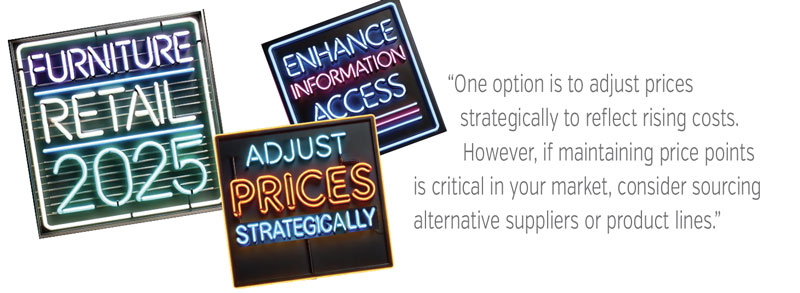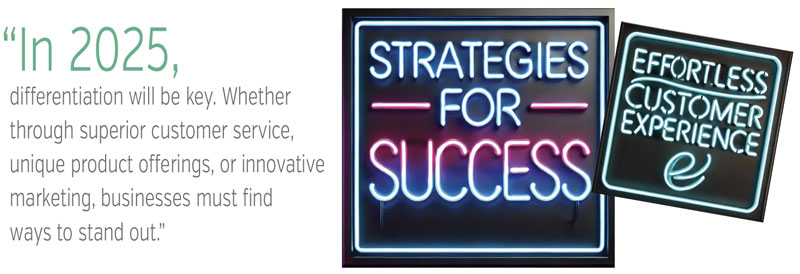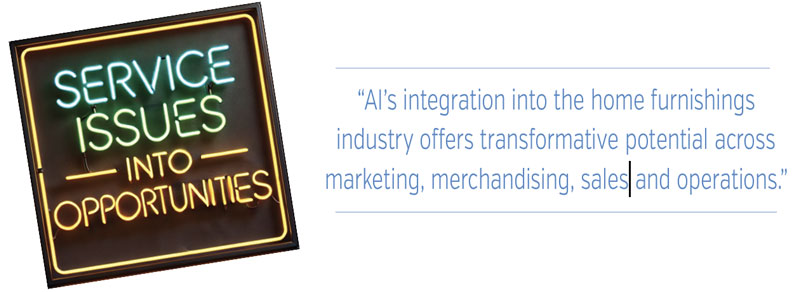by David McMahon, PerformNow
Actionable strategies & predictions to help your retail business thrive and expand market share in 2025.
As we step into a new year filled with possibilities and uncertainties, it’s clear that the home
furnishings
industry
has grown accustomed to navigating unpredictability. The COVID years taught us that resilience and adaptability
are not
just important—they are essential for survival and growth. The ability to pivot in response to changing
conditions, from
supply chain disruptions to shifting consumer behaviors, has become the hallmark of successful furniture
businesses.
In this spirit, I offer key predictions for the upcoming year and actionable strategies to leverage these
changes. By
preparing for these challenges and opportunities, you can position your business to thrive and even expand
market share.
The Overall Economy
Economic forecasts remain uncertain. Interest rates are ticking downward, and the economy shows resilience and
moderate
growth. If this trend holds, the home furnishings market will likely mirror this strength. Regardless of
economic
conditions, furniture and mattress sales will continue, driven by essential and recurring needs such as new home
purchases, remodeling, and replacements.
It’s also worth noting that the impact of economic trends can vary significantly by region. A strong local
economy can
buffer national slowdowns, while weaker areas may face headwinds. Regardless, remember that the economy is
beyond your
control. Your focus should remain on what you can influence—your operations, marketing, and customer
experience.
Expect
neither a windfall from a booming economy nor a collapse from a downturn.
Inventory Supply and Costs
Inventory costs may rise due to possible supply chain challenges, increased import taxes, and potential labor
shortages.
Therefore, you’ll need to evaluate pricing strategies carefully to maintain gross margins.
“Your focus should remain on what you can influence. Expect neither a windfall from a booming economy nor
a
collapse
from a downturn.”
One option is to adjust prices strategically to reflect rising costs. However, if maintaining price points is
critical
in your market, consider sourcing alternative suppliers or product lines. If demand remains robust, rising costs
may
actually boost revenue through higher average transaction values. Stay vigilant and flexible, and leverage tools
like
inventory management systems to monitor trends and respond quickly.
Employees
Finding and retaining skilled employees remains one of the most pressing issues for the home furnishings
industry. The
available labor pool is not expected to expand significantly in 2025. To compete for top talent, retailers must
offer
competitive wages alongside a positive and supportive workplace environment.
A favorable work environment includes more than just pay—it also means fostering a culture of growth,
recognition, and
collaboration. Investing in technology, tools, and training can differentiate your business as an employer of
choice.
Due to this ongoing challenge of finding and retaining talent, outsourcing will likely continue. Aside from
retail
selling, display and warehousing roles, most other positions can be remote or hybrid. There are opportunities to
hire
skilled employees from outside your market area. Consider using agencies to help fill roles, especially in
marketing,
lead management, accounting, and other office duties.
“There are opportunities to hire skilled employees from outside your market area. Consider using agencies
to
help
fill
roles.”
Marketing
The shift away from traditional advertising methods like TV, radio, and direct mail is accelerating. Consumers
now rely
heavily on digital channels to research products and make purchasing decisions. Digital marketing offers
targeted,
cost-effective ways to reach potential customers when they are active in the market.
Building a strong online presence is essential. Create engaging digital content to connect with your audience,
such as
videos, blogs, and social media posts. Invest in search engine optimization (SEO) to ensure your business is
visible
when consumers search for products you offer. Consider using tech to engage website visitors and focus on
providing
clear calls to action to convert leads into in-store sales.
Customer Expectations
Companies like Amazon have redefined consumer expectations, setting a high bar for convenience, speed, and
transparency.
Today’s customers want to quickly find the information they need, access products without delays, and
resolve
post-purchase issues efficiently.
To meet these expectations, retailers must invest in streamlined operations and robust customer service systems.
Make it
easier for customers to research products, check stock availability, and track orders. If problems arise, offer
multiple
channels for resolution, such as live chat, email and phone support, to ensure prompt and helpful responses. The
more
effortless you make the experience, the more likely you are to earn customer loyalty and positive reviews.

Competition
Home furnishings remain an essential category, ensuring ongoing competition from traditional and digital
players. In
2025, national brands and e-commerce platforms will increasingly encroach on local markets, offering convenience
and
competitive pricing. At the same time, smaller, traditional brick-and-mortar retailers may exit the market,
creating
challenges and opportunities for businesses that remain.
In 2025, differentiation will be key. Whether through superior customer service, unique product offerings, or
innovative
marketing, retailers must find ways to stand out. Look for gaps in the market you can fill and consider
expanding into
related product categories or services to diversify revenue streams.
Technology
Technology is evolving faster than ever, largely driven by advancements in AI and automation. Keeping up can be
daunting, but chasing every new trend is counterproductive. Instead, focus on technologies that align with your
strategic goals.
Invest in tools that improve customer experience, such as CRM systems, mobile-friendly websites, and
point-of-sale
solutions. Automation can also streamline operations, from inventory management to marketing workflows. Partner
with
technology providers that offer scalable solutions and ongoing support to ensure you maximize the value of your
investment.

Strategies for Success
-
Elevate the Customer Experience.
The cornerstone for success in 2025 and beyond is to deliver an exceptional customer
experience. Map the entire customer
journey, from initial engagement to post-purchase interactions, and identify areas for improvement. For
example:
- Enhance lead management to engage potential customers early.
- Simplify in-store sales processes for a smoother experience.
- Automate follow-ups for open orders and post-delivery surveys.
By addressing every touchpoint, you can create a seamless experience that delights customers and builds
loyalty.
-
Enhance Information Access.
Customers expect immediate access to accurate information. Equip your staff with tools like
tablets or mobile apps to
efficiently answer questions and complete transactions. Having the right information at their fingertips
improves the
customer experience and increases the likelihood of a sale.
-
Accelerate Transactions.
In a fast-paced world, customers value efficiency. Streamline the shopping experience by:
- Digitally creating wish lists during the sales process.
- Automating order creation and payment processing.
- Scheduling follow-ups with customers using digital calendars.
These steps reduce friction and make the shopping experience more enjoyable for customers and staff.

-
Automate Order Updates.
Automation is essential, given the high volume of delayed or follow-up transactions in the
home furnishings industry.
Tools that notify customers about order status, delivery updates or product availability without
requiring
manual
intervention save time and enhance transparency and trust.
-
Turn Service Issues Into Opportunities.
While service challenges can be frustrating, they present an opportunity to build loyalty.
To resolve issues quickly and
efficiently, implement digitized ticketing systems that integrate with your CRM. Proactive communication
and
timely
follow-ups can turn dissatisfied customers into brand advocates.
-
Leverage AI and Automation.
Workflow automation is no longer optional—it’s necessary to stay competitive. Examples
include:
-
Marketing automation: If a customer comes into your store but does not buy, send
an automated text and e-mail to thank them for their visit.
At the same time, automate a follow-up notice to remind an associate to touch base with that
prospect.
-
Sales automation: If a customer doesn’t add accident protection, send them
an
automated reminder offer prior to delivery.
-
Open sales follow-up automation: Send an e-mail every two weeks to customers
with an open sale that includes a link to check their order status.
-
Post-delivery automation: Upon delivery, simultaneously send a branded e-mail
with a thank you message and next purchase survey. Include photos of
the delivery and copy the salesperson.
-
Past purchase follow-up automation: Trigger a salesperson follow-up reminder six
months after purchase.
-
Related item automation: Use for popular brand introductions and products with
followings.
-
Marketing automation in AI: One of the greatest uses of AI is to generate and
refine content. Connect your marketing resources with your CRM to help
expand and use content to increase relevance with your audience.
-
Loyalty and VIP programs: If you have a subscription service, VIP service or
loyalty program, trigger monthly messages to these segmented parts of
your database. This will lead to higher rates of media engagement.
By focusing on these predictions and strategies, your business can navigate the challenges of a dynamic market
and seize
new growth opportunities. Success lies in being proactive, adaptable, and committed to delivering value at every
step of
the customer journey.